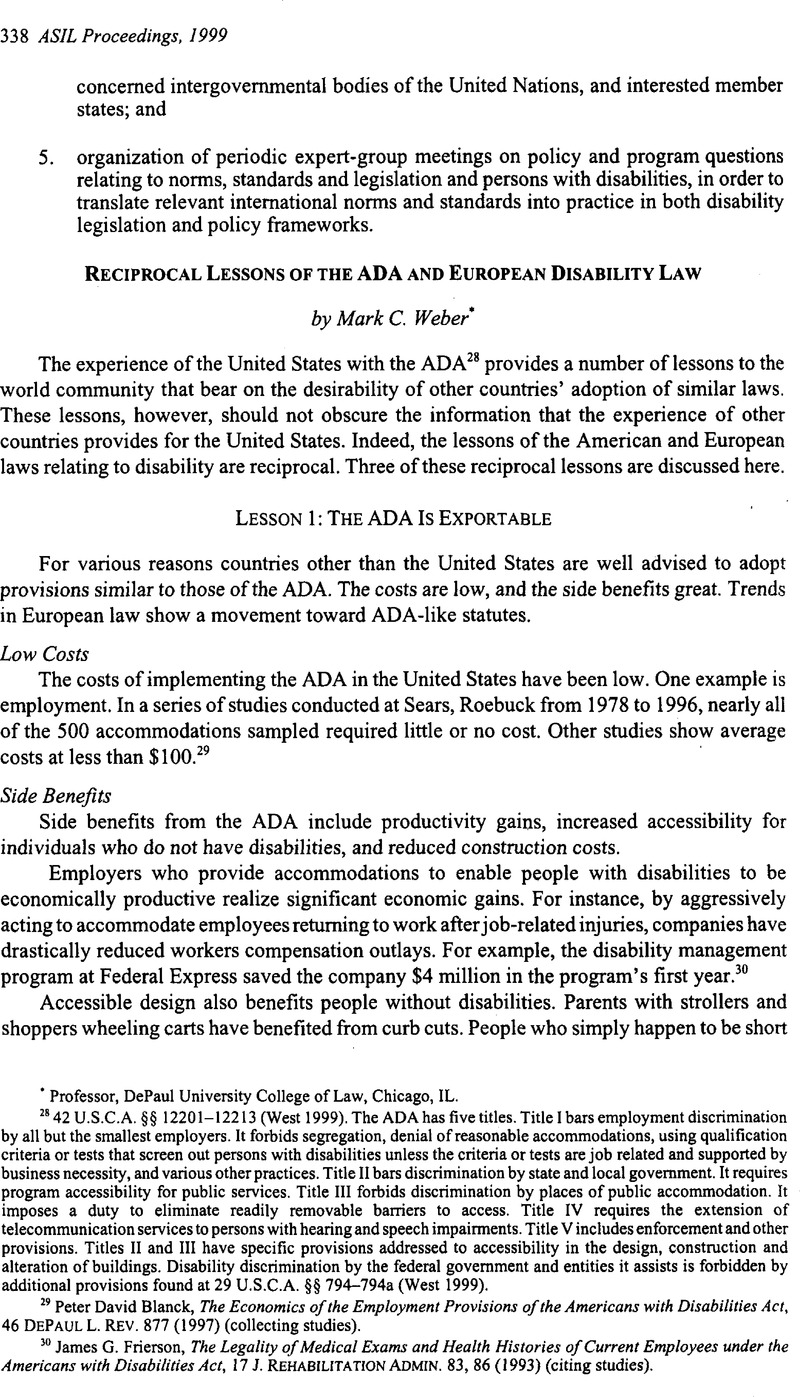No CrossRef data available.
Published online by Cambridge University Press: 28 February 2017

28 42 U.S.C.A. §§ 12201-12213 (West 1999). The Ada has five titles. Title I bars employment discrimination by all but the smallest employers. It forbids segregation, denial of reasonable accommodations, using qualification criteria or tests that screen out persons with disabilities unless the criteria or tests are job related and supported by business necessity, and various other practices. Title Ii bars discrimination by state and local government. It requires program accessibility for public services. Title Iii forbids discrimination by places of public accommodation. It imposes a duty to eliminate readily removable barriers to access. Title IV requires the extension of telecommunication services to persons with hearing and speech impairments. Title V includes enforcement and other provisions. Titles Ii and Iii have specific provisions addressed to accessibility in the design, construction and alteration of buildings. Disability discrimination by the federal government and entities it assists is forbidden by additional provisions found at 29 U.S.C.A. §§ 794-794a (West 1999).
29 Blanek, Peter David, The Economics of the Employment Provisions of the Americans with Disabilities Act, 46 Depaul L. Rev. 877 (1997)Google Scholar (collecting studies).
30 Frierson, James G., The Legality of Medical Exams and Health Histories of Current Employees under the Americans with Disabilities Act, 17 J. Rehabilitation Admin. 83, 86 (1993)Google Scholar (citing studies).
31 Sources describing these developments and providing citations to the applicable provisions include Gutow, Bemard, Survey of Rights of Workers with Disabilities: Comparison of the United States with the European Community, 11 N. Y. Int’l L. Rev. 101 (1998)Google Scholar; Rasnic, Carol D., A Comparative Analysis of Federal Statutes for the Disabled Worker in the Federal Republic of Germany and the United States, 9 Ariz. J. Int’l & Comp. L. 283 (1992)Google Scholar; Waddington, Lisa, Reassessing the Employment of People with Disabilities in Europe: From Quotas to Anti-Discrimination Laws, 18 Comp. Lab. L. J. 62 (1996)Google Scholar; Bernstein, Josh, Comment, The Enforcement of European Union Directives on Employment of the Disabled, 30 Tex. Int’l L.J. 603 (1995)Google Scholar; Besner, Eric A., Comment, Employment Discrimination for Disabled Individuals: What Can France Learn from the Americans with Disabilities Act, 16 Comp. Lab. L.J. 399 (1995)Google Scholar.
32 Great Lakes Disability and Business Technical Assistance Center, Harris Poll Results, Region V News, Spring/Summer 1998, at 1 (collecting statistical sources).
33 Mitchell P. LaPlante et al., Disability and Employment #11, Disability Statistics Abstract, Sept. 8, 1997 (collecting statistical sources).
34 See, e.g., Baldwin, Marjorie L., Can the Ada Achieve Its Employment Goals, 549 The Annals 37, 42 (1997)Google Scholar.
35 See, e.g., Casper, Marta W., Seasons of Change, The Americans with Disabilities Act: Implementation in the Workplace, 17 J. Rehabilitation Admin. 129, 132 (1993)Google Scholar (describing employers’ continuing attitudinal barriers to hiring persons with disabilities).
36 For citations to sources on these programs and a more detailed argument in favor of the adoption of comparable provisions in the United States, see Weber, Mark C., Beyond the Americans with Disabilities Act: A National Employment Policy for People with Disabilities, 46 Buff. L. Rev. 123, 166-74 (1998)Google Scholar.
37 For a citations to sources on European programs and a more detailed argument in favor of the adoption of comparable provisions in the United States, see Mark C. Weber, Disability and the Law of Welfare: A Post-Integrationist Examination 89-95 (Apr. 1999) (unpublished manuscript, on file with author).
38 See id. at 104-06.
39 For a citations to sources and a more detailed argument in favor of the adoption of medical insurance provisions in the United States, see id.